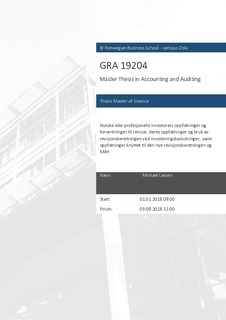Norske ikke-profesjonelle investorers oppfatninger og forventninger til revisor, deres oppfatninger og bruk av revisjonsberetningen ved investeringsbeslutninger, samt oppfatninger knyttet til den nye revisjonsberetningen og KAM
Master thesis

View/
Date
2018Metadata
Show full item recordCollections
- Master of Science [1621]
Abstract
The audit profession and the audit report have, as a result of several large
accounting scandals and the financial crisis of 2007-2008, been subject to large
amounts of criticism and the value of auditing has been questioned by, among
others, investors.
The theme of this master thesis is Norwegian non-professional investors’
perceptions and expectations for the auditor and the audit, as well as their
perceptions and use of the audit report in investment decisions. Since the audit
report recently has undergone significant changes, the current thesis has also
attempted to measure Norwegian non-professional investors’ perceptions of these
changes. There has been no research in this field in Norway before, as I am aware
of.
To answer the research questions, a quantitative web-based survey was conducted,
as well as three subsequent qualitative semi-structured interviews to gain a deeper
understanding of the results from the survey.
The findings show that Norwegian non-professional investors expect absolute
assurance from the auditor and the audit only to a small extent, with regard to the
uncovering of material misstatements, i.e. error and fraud. This indicates that an
expectation gap regarding the level of assurance provided by an audit is not
widespread among this user group. The results also show that the majority of
Norwegian non-professional investors rarely or never use the audit report in
investment decisions, and that those who use it are essentially only interested in
whether or not the audit report is clean. Regarding the new audit report and the
implementation of KAM, the results show that Norwegian non-professional
investors may not understand the information communicated in the KAM section,
they are not familiar with KAM or that they are still only interested in the
conclusion in the audit report. However, the results indicate that the KAM section
has somewhat contributed to an increased understanding of the auditor’s role and
that the new audit report, as a whole, is perceived to be less standardized and
easier to read and understand, compared to the former audit report. However, I
advise future research to elaborate further on this subject, which is discussed in
chapter six and seven of this thesis.
Description
Masteroppgave(MSc) i Master i regnskap og revisjon - Handelshøyskolen BI, 2018